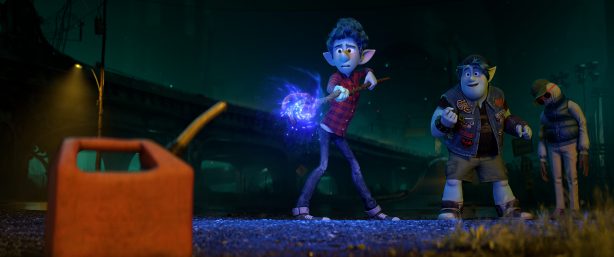In Disney and Pixar’s new animated adventure Onward, two teenage elf brothers (voices of Tom Holland and Chris Pratt) try using a magic spell to resurrect their late father for 24 hours. The story is inspired by the bond director Dan Scanlon formed with his older brother following their own father’s death. “He’s always been a mystery to us. A family member sent us a tape recording of him saying just two words: ‘hello’ and ‘goodbye.’ Two words,” Scanlon says. “But to my brother and me—it was magic.”
Set in a suburban fantasy world, Onward arrives in theaters today with its own distinctive brand of magic. To produce the spells visually, Pixar’s effects team watched several films—including Disney’s Aladdin, Hercules and Peter Pan—to understand how audiences have envisaged magic onscreen. After conducting further research, they decided to create a new shape language to fit the narrative of Onward.
According to effects supervisor Vincent Serritella, the effects team ultimately turned two-dimensional graphics and shapes into “light objects,” then created a three-dimensional, volumetric, glowing atmosphere around them—something “new for Pixar.” Conveying magic onscreen was a surprisingly complicated process. “It’s an abstract concept. We had to personify something that is supposed to be invisible,” he says. “When we went too young with the look of magic, it felt out of place. Like, if we had added pixie dust, it wouldn’t fit in a fantasy world with two teenage boys. And if the magic looked too realistic, it wouldn’t fit in, either, since our world is so stylized.”

The first time Ian (Holland) casts a magical spell in Onward, it catches both him and his brother, Barley (Pratt), by surprise—and not just because it only brings back half of their father’s body. As Ian’s power grows, so too does the visual strength of each incantation. “For every sequence, we came up with this ‘magic theory’ packet where we would track and plot the intensity of the spell, and the success rate of the spell, and accompany it with how much visual screen space it occupies,” Serritella says. “Once other departments heard about it, they asked us for copies of it, because then they could support the ideas through animation, camera, lighting, etc.” The spells were categorized in various levels to determine how elaborate to make the magic appear, with color defining certain aspects. “Dad was always represented by violet,” he says. “And if a spell went wrong, we tended to shift the color to make it very clear.”
“I’m really proud of how we tackled solving such an abstract problem and got everyone on the same page,” says Serritella. “It all boiled down to one central question: ‘Is this supportive of what the sequence or what the story is trying to say?’”
Disney and Pixar’s Onward is now playing in theaters nationwide.